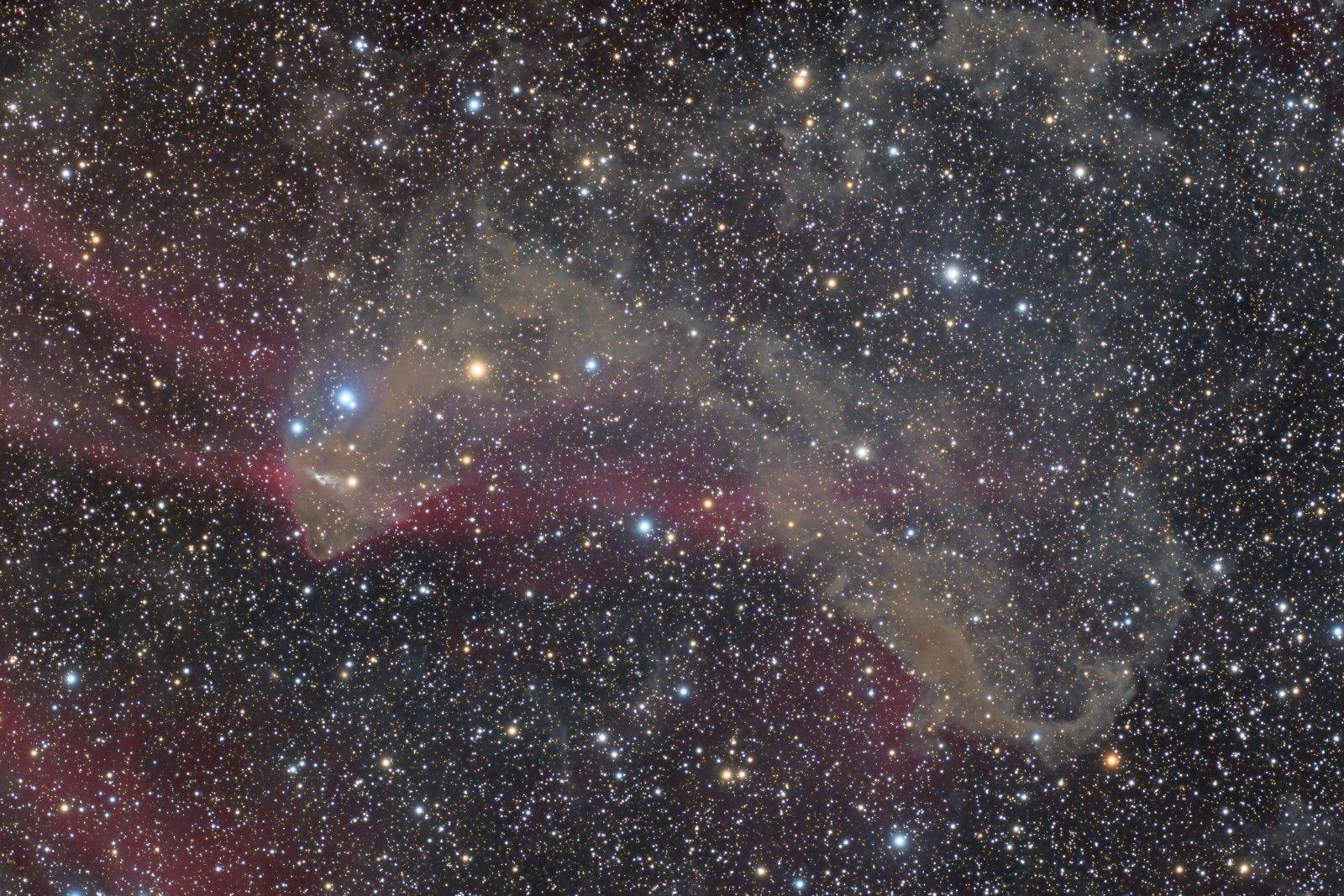LBN 437 and Sh2-126
 Click image for full size version (8 MB)
Click image for full size version (8 MB)
October 3, 2021
LBN 437 is a complex nebula in Lacerta, the Lizard. In keeping with the reptilan theme, LBN 437 looks to me like a gecko seen from above. However, Gail says it is more amphibian in nature, resembling this petrified toad poo we found in our driveway. You be the judge; I’m going with gecko.
I had originally planned to shoot only broadband (“natural” colour), but when I saw the faint red glow of Sh2-126 in the first few frames, I decided to get some H-alpha data to better reveal the dim red structures in the region, including the edge of the “snout,” which looks like a shock wave. This structure was very clear in the H-alpha image. The acronym “LBN” refers to Lynd’s Catalogue of Bright Nebulae. This catalogue’s entries were identified by inspection of red and blue images from the National Geographic – Palomar Observatory Sky Atlas.
Tekkies:
Acquisition, focusing, and control of Paramount MX mount with N.I.N.A., TheSkyX and PHD2. Focus with Optec DirectSync motor and controller. Equipment control with PrimaLuce Labs Eagle 4 Pro computer. All pre-processing and processing in PixInsight. Acquired from my SkyShed in Guelph. AVerage or better transparency and seeing. Data acquired September 6-24, 2021.
Luminance: Sky-Watcher Esprit 150 f/7 refractor and QHY600M camera with Optolong UV/IR filter
Chrominance: Takahashi FSQ-106 ED IV @ f/5 and QHY367C Pro one-shot colour camera with Optolong UV/IR filter
Data Reduction and Initial Processing
Preprocessing: The WeightedBatchPreProcessing script was used to create Luminance and H-alpha master frames from the mono camera and an RGB master frame from the one-shot colour camera. DrizzleIntegration (2x CFA Drizzle) was applied to the RGB set. The RGB master was registered to the Luminance master using StarAlignment.
Noise Reduction: The MUREDenoise script was applied to the Luminance and Ha master frames (20 iterations using settings determined with MureDenoiseDetectorSettings script).
Gradient Removal: DBE was applied to each of the three masters using Subtraction.
Colour
Colour Balance: Colour was balanced with PhotometricColorCalibration.
Linear Noise Reduction: MultiscaleLinearTransform was used to reduce noise in the background areas, using an internal mask to protect bright structures. Layer settings for threshold and strength: Layer 1: 5.0 0.95, 2 iterations; Layer 2: 4.0, 0.85, 2 iterations.
Stretching: HistogramTransformation was applied to make a pleasing, bright image, with background set to an intensity of approximately 0.10.
Lightness and H-alpha
Deconvolution: A star mask was made from the Luminance master to use as a Local Deringing Support Image. The GAME script was used to make a mask selecting only two galaxies and one other region for deconvolution. Deconvolution was applied (30 iterations, regularized Richardson-Lucy, ParametricPSF mode with default settings; Global dark deringing = 0.03; Global bright deringing 0.005).
Linear Noise Reduction: MultiscaleLinearTransform was used to reduce noise in the background areas, using an internal mask to protect bright stars. Layer settings for threshold and strength: Layer 1: 3.0 0.85, 1 iterations; Layer 2: 2.0, 0.75, 1 iterations.
Stretching: HistogramTransformation was applied to make a pleasing, bright image, with background set to an intensity of approximately 0.10.
Combining Lightness, H-alpha and Colour Images
LRGB Combination: The lightness image was applied to the RGB image using LRGBCombination with default settings.
H-alpha Blending: PixelMath was used to add H-alpha to the LRGB image (the target image, $T), using the following expressions for the R, G and B channels:
R: max($T[0], 1.2*Ha)
G: $T[1]
B: iif($T[0]<Ha, $T[2] + 0.06*Ha, $T[2])
Additional Processing
Nonlinear Noise Reduction: TGVDenoise was used in L*a*b* mode to reduce noise with a mask used to target the background areas and protect the stars and nebula (max. 1,000 iterations and convergence selected for both lightness and chrominance).
Contrast Enhancement: LocalHistogramEqualization was applied using an inverted star mask to protect the stars (scale 50, max contrast 1.5, strength 0.18, 1 iteration followed by scale 150, max contrast 1.5, strength 0.25).
Sharpening: MultiscaleLinearTransform was used to sharpen Layers 2 and 3 with strengths of 0.1and 0.05, respectively. The mask used for deconvolution was used to limit sharpening to a few specific regions of the image.
Final Steps: Background, nebula and star brightness, contrast, and colour saturation were adjusted in several iterations using CurvesTransformation with masks as required. ICCProfileTransformation (sRGB IEC61966-2.1; Relative Colorimetric with black point compensation) was applied prior to saving in jpg format.






Your images constantly blow me away!
WOW, amazing image Ron. All that acquisition time really paid off. Love it!!!!!!!
Thanks!